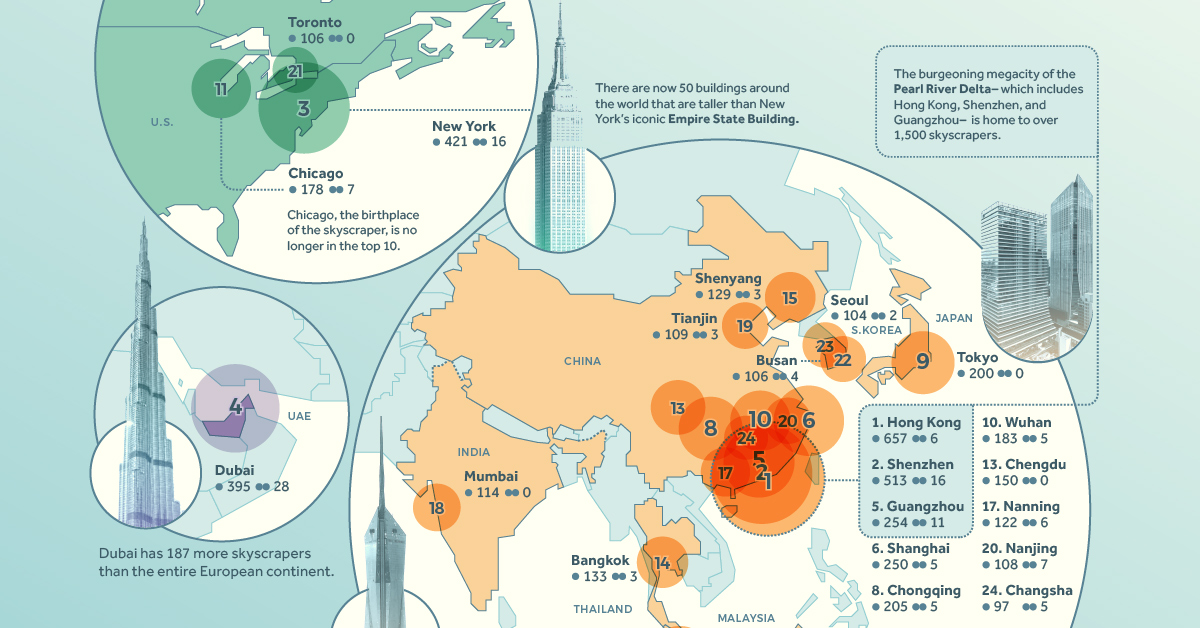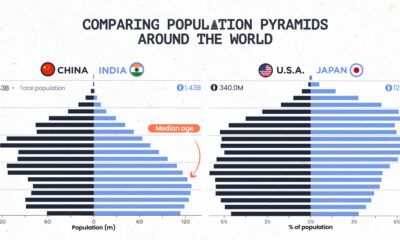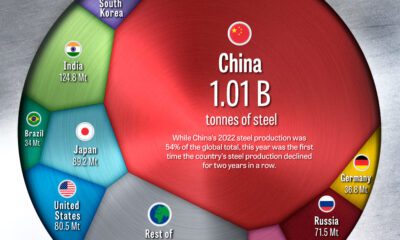Misc
Ranked: The Cities with the Most Skyscrapers in 2023
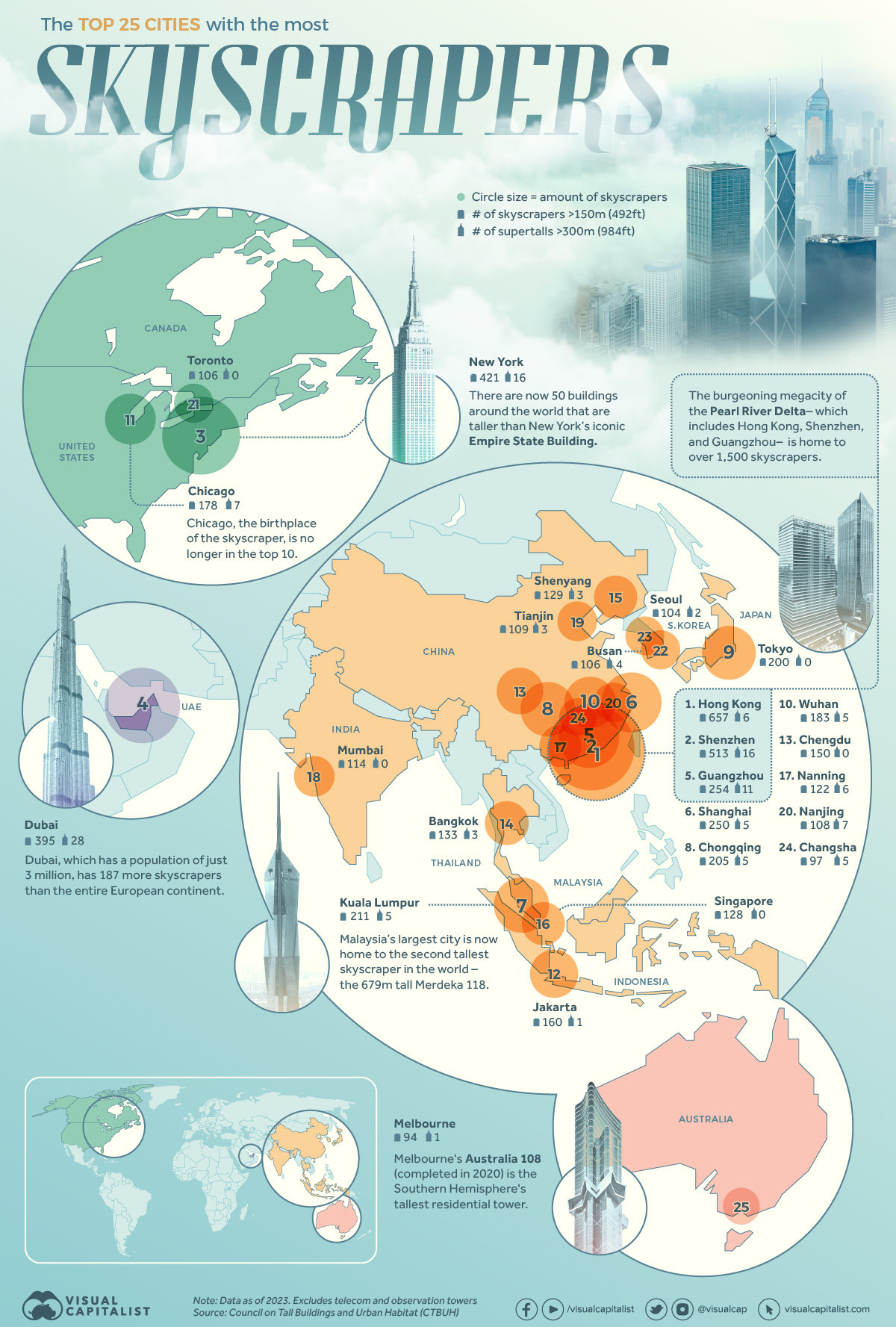
Ranked: The Cities with the Most Skyscrapers in 2023
When it comes to soaring skylines and architectural marvels, no country has embraced the vertical revolution quite like China.
In this graphic, which uses data from the Council on Tall Buildings and Urban Habitat (CTBUH), we reveal the 25 cities with the most skyscrapers and supertall buildings globally.
Unsurprisingly, China’s cities dominate the list, solidifying the country’s reputation as a global powerhouse of tall buildings.
The 25 Top Cities by Skyscraper Count
Topping the charts is Hong Kong, with an impressive 657 skyscrapers, including six supertalls (buildings over 300 meters tall).
| Rank | City | Country | Skyscrapers (>150m) | Supertalls (>300m) |
|---|---|---|---|---|
| 1 | Hong Kong | 🇨🇳 China | 657 | 6 |
| 2 | Shenzhen | 🇨🇳 China | 513 | 16 |
| 3 | New York City | 🇺🇸 United States | 421 | 16 |
| 4 | Dubai | 🇦🇪 United Arab Emirates | 395 | 28 |
| 5 | Guangzhou | 🇨🇳 China | 254 | 11 |
| 6 | Shanghai | 🇨🇳 China | 250 | 5 |
| 7 | Kuala Lumpur | 🇲🇾 Malaysia | 211 | 5 |
| 8 | Chongqing | 🇨🇳 China | 205 | 5 |
| 9 | Tokyo | 🇯🇵 Japan | 200 | 0 |
| 10 | Wuhan | 🇨🇳 China | 183 | 5 |
| 11 | Chicago | 🇺🇸 United States | 178 | 7 |
| 12 | Jakarta | 🇮🇩 Indonesia | 160 | 1 |
| 13 | Chengdu | 🇨🇳 China | 150 | 0 |
| 14 | Bangkok | 🇹🇭 Thailand | 133 | 3 |
| 15 | Shenyang | 🇨🇳 China | 129 | 3 |
| 16 | Singapore | 🇸🇬 Singapore | 128 | 0 |
| 17 | Nanning | 🇨🇳 China | 122 | 6 |
| 18 | Mumbai | 🇮🇳 India | 114 | 0 |
| 19 | Tianjin | 🇨🇳 China | 109 | 3 |
| 20 | Nanjing | 🇨🇳 China | 108 | 7 |
| 21 | Toronto | 🇨🇦 Canada | 106 | 0 |
| 22 | Busan | 🇰🇷 South Korea | 106 | 4 |
| 23 | Seoul | 🇰🇷 South Korea | 104 | 2 |
| 24 | Changsha | 🇨🇳 China | 97 | 5 |
| 25 | Melbourne | 🇦🇺 Australia | 94 | 1 |
Hong Kong, along with Shenzhen (#2), and Guangzhou (#5) are part of the burgeoning megacity known as the Pearl River Delta, which is home to over 1,500 skyscrapers. This is even more impressive when considering that Shenzhen was a small fishing village until the 1970s.
New York City secures the third position on the list, boasting an impressive tally of 421 skyscrapers. Although it may have relinquished its title to Chinese cities, the city’s skyline endures as a globally renowned symbol, prominently featuring the iconic Empire State Building. Notably, while the Empire State Building enjoys widespread familiarity, it no longer ranks among the world’s 50 tallest structures.
Rounding out the top five is Dubai in the United Arab Emirates, which grabs the fourth position with 395 skyscrapers, a staggering 28 of which are supertalls. This desert oasis has become synonymous with grandiose architecture and record-breaking structures, exemplified by the Burj Khalifa, which is the world’s current tallest building at 828 meters (2,715 ft).
China’s Numbers in Context
Looking at this data from another perspective, China actually has more skyscrapers on this list than the rest of the world combined.
| Country | Cities in Top 25 | Skyscrapers | Supertalls |
|---|---|---|---|
| 🇨🇳 China | 12 | 2777 | 72 |
| 🌐 Rest of World | 13 | 2350 | 67 |
China’s rapid urbanization, economic growth, and ambitious construction projects have fueled this impressive feat. There’s no doubt that the country’s relentless pursuit of vertical development, coupled with its booming population and thriving cities, has positioned China as the unrivaled leader in the global skyscraper race.
The Future of the Global Skyline
As the world continues to reach new heights in architectural marvels, there are even more supertall skyscrapers in the pipeline that will reshape skylines across the globe.
From the soaring Jeddah Tower in Saudi Arabia, poised to surpass the Burj Khalifa as the world’s tallest building, to the remarkable Merdeka 118 in Kuala Lumpur, which is set to claim the title of the world’s second-tallest structure when it opens in June 2023, these projects will captivate city dwellers for years to come.
Even as these new monumental buildings rise, China’s prominence in the world of skyscrapers—with three cities in the top five globally—is likely to remain unchallenged.
Politics
How Do Chinese Citizens Feel About Other Countries?
What is the Chinese public’s view of world powers? This visual breaks down Chinese sentiment towards other countries.
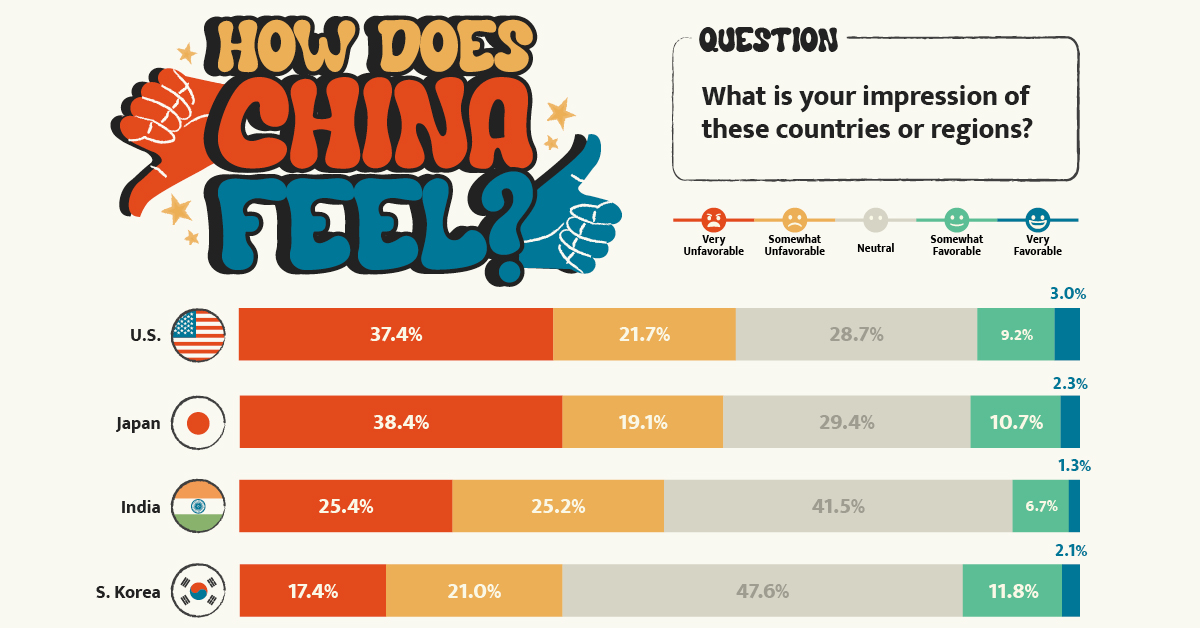
Public Opinion: How Chinese Citizens Feel About Other Countries
Tensions over Taiwan, the COVID-19 pandemic, trade, and the war in Ukraine have impacted Chinese sentiment towards other countries.
This visualization uses data from the Center for International Security and Strategy (CISS) at Tsinghua University to rank survey responses from the Chinese public on their attitudes towards countries and regions around the world.
Chinese Sentiment Towards Other Countries in 2023
In the Center’s opinion polls, which surveyed a random sample of more than 2,500 Chinese mainland adults in November 2022, Russia came out significantly ahead.
Just under 60% of respondents held Russia in a favorable view, with 19% seeing the country as “very favorable.” Contrast that to the mere 12% that viewed the U.S. in a positive light.
Here’s a closer look at the data. The percentages refer to the share of respondents that voted for said category.
| Country/Region | Very Unfavorable | Somewhat Unfavorable | Neutral | Somewhat Favorable | Very Favorable |
|---|---|---|---|---|---|
| 🇺🇸 United States | 37.4% | 21.7% | 28.7% | 9.2% | 3.0% |
| 🇯🇵 Japan | 38.4% | 19.1% | 29.4% | 10.7% | 2.3% |
| 🇮🇳 India | 25.4% | 25.2% | 41.5% | 6.7% | 1.3% |
| 🇰🇷 South Korea | 17.4% | 21.0% | 47.6% | 11.8% | 2.1% |
| 🇪🇺 European Union | 9.3% | 15.6% | 57.6% | 14.1% | 3.3% |
| Southeast Asia | 7.1% | 13.1% | 59.5% | 16.8% | 3.5% |
| 🇷🇺 Russia | 3.0% | 4.8% | 33.7% | 39.4% | 19.0% |
Japan ranked just below the U.S. in terms of overall unfavorability, though a slightly higher share of respondents saw Japan as “very unfavorable” compared to America. This is likely due to both modern tensions in the East China Sea over mutually claimed islands and historical tensions over the Sino-Japanese Wars.
Chinese sentiment towards India was also unfavorable at just over 50%, though notably the country also received the lowest favorability rating at just 8%.
Additional Survey Findings
The survey also found that 39% of Chinese people get their information on international security from Chinese state-run media (mainly through TV), with an additional 19% getting information from government websites and official social accounts. Conversely, only 1.7% get their news from foreign websites and foreign social media, partially due to the Great Firewall.
When asked about different international security issues, the biggest shares of Chinese citizens ranked the following as their top three:
- Pandemics (12.9%)
- Disputes over territory and territorial waters (12.9%)
- China-U.S. relations (12.0%)
The pandemic’s high score reflects the harsher impact COVID-19 had on China. Chinese borders were shut for years and the public faced intense measures to reduce spread.
In terms of other world events, the majority of Chinese people align with a more “Eastern” viewpoint. For example, in regards to the war in Ukraine, the report found that:
“About 80 percent of the respondents believe the U.S. and Western countries should be held most accountable [for the war], while less than ten percent of the respondents argue that Russia is mainly responsible.”– Center for International Security and Strategy, Tsinghua University
Overall, the views of the Chinese public reflect the opposite of those found in many Western countries. They provide an important insight that it is not just the Chinese government holding particular views about the world, but the Chinese public as well.
-

 Markets4 weeks ago
Markets4 weeks agoThe World’s Biggest Mutual Fund and ETF Providers
-

 Brands2 weeks ago
Brands2 weeks agoBrand Reputations: Ranking the Best and Worst in 2023
-

 Environment5 days ago
Environment5 days agoHotter Than Ever: 2023 Sets New Global Temperature Records
-

 Datastream4 weeks ago
Datastream4 weeks agoCan You Calculate Your Daily Carbon Footprint?
-

 Energy2 weeks ago
Energy2 weeks agoWho’s Still Buying Russian Fossil Fuels in 2023?
-

 VC+5 days ago
VC+5 days agoWhat’s New on VC+ in July
-

 Markets4 weeks ago
Markets4 weeks agoVisualizing BlackRock’s Top Equity Holdings
-

 apps2 weeks ago
apps2 weeks agoMeet the Competing Apps Battling for Twitter’s Market Share




